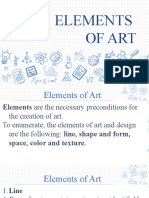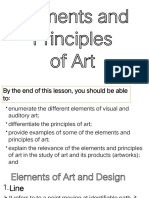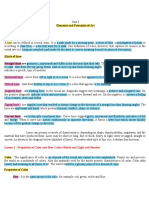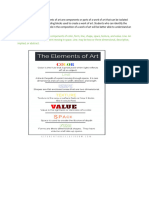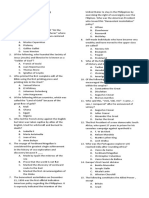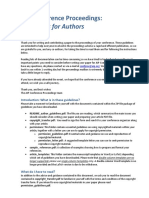0 ratings0% found this document useful (0 votes)
57 viewsElements of Arts Visual
Elements of Arts Visual
Uploaded by
RoseMarie MasongsongThis document defines and describes the key elements of art, including line, shape and form, space, color, and texture. It discusses the different types of each element, such as horizontal and vertical lines conveying different meanings, and geometric versus organic shapes found in nature. Color is described through concepts like hue, value, and intensity. Different color harmonies like monochromatic, complementary, and analogous are also outlined. Texture can be either real or implied, and is experienced through both sight and touch. These elements are the basic building blocks that artists use to create works of art.
Copyright:
© All Rights Reserved
Available Formats
Download as PPTX, PDF, TXT or read online from Scribd
Elements of Arts Visual
Elements of Arts Visual
Uploaded by
RoseMarie Masongsong0 ratings0% found this document useful (0 votes)
57 views28 pagesThis document defines and describes the key elements of art, including line, shape and form, space, color, and texture. It discusses the different types of each element, such as horizontal and vertical lines conveying different meanings, and geometric versus organic shapes found in nature. Color is described through concepts like hue, value, and intensity. Different color harmonies like monochromatic, complementary, and analogous are also outlined. Texture can be either real or implied, and is experienced through both sight and touch. These elements are the basic building blocks that artists use to create works of art.
Original Title
ELEMENTS-OF-ARTS-VISUAL
Copyright
© © All Rights Reserved
Available Formats
PPTX, PDF, TXT or read online from Scribd
Share this document
Did you find this document useful?
Is this content inappropriate?
This document defines and describes the key elements of art, including line, shape and form, space, color, and texture. It discusses the different types of each element, such as horizontal and vertical lines conveying different meanings, and geometric versus organic shapes found in nature. Color is described through concepts like hue, value, and intensity. Different color harmonies like monochromatic, complementary, and analogous are also outlined. Texture can be either real or implied, and is experienced through both sight and touch. These elements are the basic building blocks that artists use to create works of art.
Copyright:
© All Rights Reserved
Available Formats
Download as PPTX, PDF, TXT or read online from Scribd
Download as pptx, pdf, or txt
0 ratings0% found this document useful (0 votes)
57 views28 pagesElements of Arts Visual
Elements of Arts Visual
Uploaded by
RoseMarie MasongsongThis document defines and describes the key elements of art, including line, shape and form, space, color, and texture. It discusses the different types of each element, such as horizontal and vertical lines conveying different meanings, and geometric versus organic shapes found in nature. Color is described through concepts like hue, value, and intensity. Different color harmonies like monochromatic, complementary, and analogous are also outlined. Texture can be either real or implied, and is experienced through both sight and touch. These elements are the basic building blocks that artists use to create works of art.
Copyright:
© All Rights Reserved
Available Formats
Download as PPTX, PDF, TXT or read online from Scribd
Download as pptx, pdf, or txt
You are on page 1of 28
ELEMENTS OF ART
PREPARED BY: ghiann Carla p. Marasigan
Baby Rica b. leyma
Elements of Art: Visual
• Taking off from the scientific reference, elements of art are
akin to the atoms that are defined as the units or "building
blocks" of matter. Together, in a variety of combinations and
formations, they have the ability to create molecules such as
water or the more complex sucrose. These formulations are
almost the same with elements of art when they are joined
together, in a variety of ways. In the same line of reasoning.
The elements of art are the aspects of an artwork that can
be isolated from each other.
Elements of Art: Visual
• Some art forms also necessitate some of the
elements as they are inherent in the very
nature of them. For example, sculptures
automatically have the following elements
with or without the decision of the artist to
include them: shape, form, and space.
Without these elements, there is no sculpture
to begin with. Elements are the necessary
preconditions for the creation of art.
LINE
• A line refers to a point moving at an identifiable
path-it has length and direction. It also has width.
It is one-dimensional, however, it has the capacity
to either define the perimeters of the artwork
(edges) and/or become a substantial component
of the composition. It has variations in view of its
orientation/direction, shape, and thickness. These
variations import not only the visual elements into
the artwork, but suggest meaning or message
being conveyed by the artist.
Horizontal and vertical lines
- refers to the orientation of the line. Horizontal
lines are normally associated with rest or calm.
Landscapes often contain these elements as
works like these often connote a visual sense
of being parallel to the ground. It also alludes
to position of the reclined body at rest. Vertical
lines, on the other hand, connote elevation or
height, which is usually taken to mean
exaltation or aspiration for action. Together,
these lines communicate stability and firmness.
Diagonal and crooked lines
- diagonal lines convey movement and
instability, although the progression can be
seen. Crooked or jagged lines, on the other
hand, are reminiscent of violence, conflict, or
struggle.
Curved lines
-these are lines that bend or coil. They allude
to softness, grace, flexibility, or even sensuality.
Shape and Form
• These two are related to each other in the sense
that they define the space occupied by the object
of art Shape refers to two dimensions: height and
width, while form refers to three dimensions:
height, width, and depth. Even if shapes are part
of a bigger picture each can be identified by
breaking the visual components apart and
making distinctions based on what we know and
what we have seen.
Shape and Form
Geometric- these shapes find origin in
mathematical propositions as such, its
translation and use are often man-made.
These include shapes such as squares,
triangles, cubes, circles, spheres, and comes
among others.
Organic - organic shapes are those readily
occurring in nature, often irregular and
asymmetrical.
Geometric Organnic
SPACE
• Related to shape and form is space which is
usually inferred from a songs of depth, whether it
is real or simulated. Real space is three-dimension
like what has been previously mentioned,
sculptures are a perfect example of artworks that
bear this element. However, this can only be
manifested two-dimensional artworks through the
use of different techniques, or the use (or non-
use) of area around a drawing or picture
SPACE
Positive and negative space- usually
identified with the white is the negative
space. The positive space on the other
hand, is the space where shadow is
heavily used.
Three-dimensional space- can be
simulated through a variety of
techniques.
Color
• Color is perhaps one of the elements that enhances the
appeal of an artwork. Its effect has range, allowing the
viewer to make responses based on memory, emotion
and instinct, among others. Color is not intrinsic to an
object and without light, one cannot perceive color. Much
of what we know about Colors begins with the notion of a
Color Theory that was first unraveled by The experiments
undertaken by Sir Isaac Newton in 1666. A ray of sunlight
passing through a prism reveals an array of colors akin to
that of a rainbow. .An upshot of this color theory is the
creation of a color wheel.
Property of Color
• a. Hue – this dimension of color gives its
name. It can be subdivided into:
Primary colors – red, yellow, and blue
Secondary colors – green, orange, and
violet
Tertiary colors – six in total, these hues
are achieved when primary and secondary
colors are mixed
Property of Color
b. Value – this refers to the brightness or
darkness of color. Often, this is used by artists to
create the illusion of depth and solid ty, a
particular mood, communicate a feeling, or in
establishing a scene (e.g day and night),
Light colors – taken as the source of light in
the composition
Dark colors – the lack or even absence of
light
Property of Color
• Each primary color has a range of values
based on the addition and diminishing
quantity and quality of light.
Tint – this is a lighter color than the
normal value (e.g. pink for red)
Shade – this is a darker color than the
normal value (e.g., maroon for red)
Property of Color
c. Intensity – this is the color’s brightness or
dullness. It is identified as the strength of
color whether it is vivid or muted. To achieve
a specific intensity of a color, one may add
either gray or its complementary color.
Bright or warm colors- positive energy
Dull or cool colors – sedate/soothing,
seriousness or calm
Color Harmonies
• To better understand intensity of color, color
harmonies are to be considered.
Monochromatic harmonies – use the
variations of a hue. An example is Claud
Monet’s “Houses of Parliament.”
Complementary harmonies - involve two
colors opposite each other in the color wheel.
Since they are at contrary positions, the
reaction is most intense
Monochromatic harmonies
Complementary harmonies
Color Harmonies
Analogous harmonies - make use of two colors
beside each other in the color wheel.
Other harmonies have emerged such as triadic
harmonies, which make use of three colors
from equidistant sites within the color wheel.
This however, does not mean that artists will
limit themselves to these kinds of harmonies.
These are but jump-off points that artists and
other creative use.
Analogous harmonies
Texture
• Like space, texture can be either real or
implied. This element in an artwork is
experienced through the sense of touch
(and sight). This element renders the art
object tactile. This was achieved using
the techniques employed by the artist in
creating the work
Texture
Texture
a. Textures in the two-dimensional plane
- texture can be implied using one technique
or a combination of other elements of art. By
creating this visual quality in the artwork, one
can imagine how the surface will feel if it was to
be touched. Some of the words used to
describe texture are the following: rough or
smooth, hard or soft, hairy, leathery, sharp or
dull, etc.
Texture
b. Surface texture
- refers to the texture of the three-
dimensional art
Thank you for
listening and have a
good day!
You might also like
- Essence Variety of LawsDocument8 pagesEssence Variety of LawsRoseMarie MasongsongNo ratings yet
- Composition: The Anatomy of Picture MakingFrom EverandComposition: The Anatomy of Picture MakingRating: 3.5 out of 5 stars3.5/5 (3)
- Imaging and Design For Social Impact: Endterm Lesson 1Document44 pagesImaging and Design For Social Impact: Endterm Lesson 1Jayr Flores88% (8)
- Making A Poster Rubric 1Document1 pageMaking A Poster Rubric 1Joylyn CatalanNo ratings yet
- v3FxcT4WSKylD9bD5A3h The Hard Surface E-BookDocument86 pagesv3FxcT4WSKylD9bD5A3h The Hard Surface E-BookAbyaz Nabeel Fazl MahardhikaNo ratings yet
- Elements of Art: Visual Elements of Art: Auditory Principles of ArtDocument35 pagesElements of Art: Visual Elements of Art: Auditory Principles of ArtRezia Ariane Grace Tobias100% (1)
- Elements and Principles of ArtsDocument9 pagesElements and Principles of ArtsJireh LumaynoNo ratings yet
- Art AppDocument23 pagesArt AppAbdulnasser Nanding Jr.No ratings yet
- GECO 6 LAS 7 ELEMENTS and PINCIPLES of ARTS OCT 2023Document6 pagesGECO 6 LAS 7 ELEMENTS and PINCIPLES of ARTS OCT 2023lovitekielNo ratings yet
- 11 Painting - Fundamentals of Visual Art - Notes and Video LinkDocument4 pages11 Painting - Fundamentals of Visual Art - Notes and Video Linksneha0% (1)
- Elements of ArtDocument56 pagesElements of ArtArenvy JazzieNo ratings yet
- Grade 12 ReviewerDocument4 pagesGrade 12 ReviewerKyleen VinluanNo ratings yet
- Arts Lesson 1Document45 pagesArts Lesson 1michelle.balenaNo ratings yet
- NOTES 7 ON ART APPRECIATION ELEMENTS and PERSPECTIVES ON ARTDocument5 pagesNOTES 7 ON ART APPRECIATION ELEMENTS and PERSPECTIVES ON ARTselwynsuico38No ratings yet
- Objectives:: TextureDocument11 pagesObjectives:: TextureChammy DelaGanarNo ratings yet
- The Visual Language Handouts EditedDocument8 pagesThe Visual Language Handouts EditedLara Concepcion CabigoNo ratings yet
- Art AppDocument15 pagesArt AppBeh Verly Co TorreonNo ratings yet
- Elements and Principles of ArtDocument23 pagesElements and Principles of ArtGeoff MacarateNo ratings yet
- Elements of ArtsDocument24 pagesElements of Artsber tingNo ratings yet
- Q1arts10module1 221210131238 21e253e0Document73 pagesQ1arts10module1 221210131238 21e253e0Angelica RocamoraNo ratings yet
- The Elements of ArtDocument7 pagesThe Elements of ArtTitus NoxiusNo ratings yet
- RVA Hand Out 2Document4 pagesRVA Hand Out 2Queniejoy ArsenalNo ratings yet
- Lesson 4-Elements of ArtsDocument41 pagesLesson 4-Elements of ArtsJessa Mae BasaNo ratings yet
- Minding The Arts (By Leynes & Fajardo PDFDocument236 pagesMinding The Arts (By Leynes & Fajardo PDFPrincess Gloriani0% (1)
- The Elements of Art and Principles of Design Final HandoutDocument7 pagesThe Elements of Art and Principles of Design Final HandoutMagadia Mark JeffNo ratings yet
- Elements of ArtDocument41 pagesElements of ArtJay Martin Yaun67% (3)
- Assignment in Contemporary Philippine Arts From The RegionDocument2 pagesAssignment in Contemporary Philippine Arts From The RegionJullie SolanoNo ratings yet
- Lesson 1 - Line and Kinds of LineDocument11 pagesLesson 1 - Line and Kinds of LineNestyn Hanna VillarazaNo ratings yet
- Module 2 Lesson 2Document9 pagesModule 2 Lesson 2Maisa VillafuerteNo ratings yet
- Organization in The Arts:: Elements of Design Principles of DesignDocument53 pagesOrganization in The Arts:: Elements of Design Principles of DesignJC RobertNo ratings yet
- Module 3 Visual Elements of ArtDocument4 pagesModule 3 Visual Elements of ArtAsh Hellion TadeoNo ratings yet
- In Your Folio, Record What You Understand by Line, Colour, Shape, Composition and Texture? LineDocument3 pagesIn Your Folio, Record What You Understand by Line, Colour, Shape, Composition and Texture? LineNieyfa RisyaNo ratings yet
- Art App - Minding The ArtsDocument236 pagesArt App - Minding The ArtsMikee Brobio San Miguel67% (3)
- Chapter 3 - Visual ArtsDocument103 pagesChapter 3 - Visual Artsarani ahmad ridhaNo ratings yet
- Lesson 2Document15 pagesLesson 2Joshua Sapphire AmonNo ratings yet
- Elements of ArtDocument50 pagesElements of ArtBango Althea MarielleNo ratings yet
- 1.1 (Visual Elements)Document22 pages1.1 (Visual Elements)Bautista Ayesha Mikhaila (A-kun)No ratings yet
- Rva 4Document33 pagesRva 4Jacob Andrew DuronNo ratings yet
- Elements AND Principles of ArtDocument13 pagesElements AND Principles of ArtwaterbottleNo ratings yet
- Lesson 7. Elements and Principles of ArtDocument83 pagesLesson 7. Elements and Principles of ArtSophiaEllaineYanggatLopez100% (7)
- Aesthetic PerceptionDocument16 pagesAesthetic PerceptionHELMSELLE JISONNo ratings yet
- HUMSS REVIEWER GR12 1st SEM MIDTERMSDocument11 pagesHUMSS REVIEWER GR12 1st SEM MIDTERMSJames CruzNo ratings yet
- The Elements of Visual ArtsDocument4 pagesThe Elements of Visual ArtsJessa CancinoNo ratings yet
- MODULE 4.pptx 2023 2024Document18 pagesMODULE 4.pptx 2023 2024Isaiah Luis BlancaflorNo ratings yet
- Elements and Principles of ArtDocument9 pagesElements and Principles of Arttina troyNo ratings yet
- Appendix B: Elements and Principles of DesignDocument6 pagesAppendix B: Elements and Principles of DesignJennifer StraussNo ratings yet
- Elements of Art Principles of Design Art Criticism - HandoutDocument4 pagesElements of Art Principles of Design Art Criticism - Handoutapi-294607284No ratings yet
- Elements and Principles of ArtDocument55 pagesElements and Principles of ArtFelipe Glenn AmoyanNo ratings yet
- Music and Arts Review GRADE 10Document6 pagesMusic and Arts Review GRADE 10Roshan Jennel BrilloNo ratings yet
- Elements and Principles of Art: Learning Outcomes Lesson 6Document34 pagesElements and Principles of Art: Learning Outcomes Lesson 6anon_719180953No ratings yet
- Elements of ArtDocument21 pagesElements of ArtDesiree Mae Gabut50% (2)
- Art App - Art Elements & PrinciplesDocument109 pagesArt App - Art Elements & PrinciplesWilliam HallareNo ratings yet
- Pointersforcontemporary 2Document8 pagesPointersforcontemporary 2Dyryn PepitoNo ratings yet
- Cpar Wk1 Lesson 1 StudentDocument42 pagesCpar Wk1 Lesson 1 StudentBen Cyrus PangapalanNo ratings yet
- Lesson - 8 - Elements-And-Principles-Of-ArtDocument87 pagesLesson - 8 - Elements-And-Principles-Of-ArtNiel Adrian C. ContrerasNo ratings yet
- Group 4 Outline FinaleeDocument12 pagesGroup 4 Outline FinaleeRay Allen Bionson RomeloNo ratings yet
- CPAR 2 - Elements of ArtDocument46 pagesCPAR 2 - Elements of ArtXandro AdrianoNo ratings yet
- Art Appreciation Lesson 2 Elements and Principles of ArtDocument52 pagesArt Appreciation Lesson 2 Elements and Principles of ArtbernaldcatliNo ratings yet
- ELEMENT OF ARTS The Elements of Art Are Components or Parts of A Work of Art That Can Be Isolated and Defined - Docx123456.docx123456Document12 pagesELEMENT OF ARTS The Elements of Art Are Components or Parts of A Work of Art That Can Be Isolated and Defined - Docx123456.docx123456Sticker WorksNo ratings yet
- CPAR LessonDocument4 pagesCPAR LessonIekzkad RealvillaNo ratings yet
- Unit 2. 3. Elements and Principles of ArtDocument72 pagesUnit 2. 3. Elements and Principles of ArtLuis Norbert Santiago100% (1)
- Lesson 5 - Elements of Art and CompositionDocument60 pagesLesson 5 - Elements of Art and CompositionPrince Aaron KobeNo ratings yet
- Special Subjects: Basic Color Theory: An Introduction to Color for Beginning ArtistsFrom EverandSpecial Subjects: Basic Color Theory: An Introduction to Color for Beginning ArtistsRating: 3.5 out of 5 stars3.5/5 (3)
- Urban GeographyDocument39 pagesUrban GeographyRoseMarie MasongsongNo ratings yet
- The Declaration of State Principles and PoliciesDocument23 pagesThe Declaration of State Principles and PoliciesRoseMarie MasongsongNo ratings yet
- Types of GovernmentDocument15 pagesTypes of GovernmentRoseMarie Masongsong100% (1)
- Outline-Belief of Origon PF Life and Racial EqualityDocument85 pagesOutline-Belief of Origon PF Life and Racial EqualityRoseMarie MasongsongNo ratings yet
- Origins and History of GlobalizationDocument20 pagesOrigins and History of GlobalizationRoseMarie MasongsongNo ratings yet
- Models of Urban GrowthDocument24 pagesModels of Urban GrowthRoseMarie MasongsongNo ratings yet
- Process of UrbanizationDocument30 pagesProcess of UrbanizationRoseMarie MasongsongNo ratings yet
- 1 World-History-2Document20 pages1 World-History-2RoseMarie MasongsongNo ratings yet
- Syllabus Urban GeoDocument3 pagesSyllabus Urban GeoRoseMarie MasongsongNo ratings yet
- Globalization and RegionalizationDocument15 pagesGlobalization and RegionalizationRoseMarie Masongsong0% (1)
- Integrative Methods Chapter 1 Curriculum IntegrationDocument21 pagesIntegrative Methods Chapter 1 Curriculum IntegrationRoseMarie MasongsongNo ratings yet
- Educ 107 - Human Acts & Gender Culture - Rose Marie MasongsongDocument50 pagesEduc 107 - Human Acts & Gender Culture - Rose Marie MasongsongRoseMarie MasongsongNo ratings yet
- Economic Globalization, Poverty, and InequalityDocument7 pagesEconomic Globalization, Poverty, and InequalityRoseMarie MasongsongNo ratings yet
- Budget An D Budgeting PR OcessDocument25 pagesBudget An D Budgeting PR OcessRoseMarie MasongsongNo ratings yet
- Article 3 - ReviewDocument41 pagesArticle 3 - ReviewRoseMarie MasongsongNo ratings yet
- Edu 105-Rose Marie MasongsongDocument55 pagesEdu 105-Rose Marie MasongsongRoseMarie MasongsongNo ratings yet
- Edu 107-Rose Marie Masongsong - Values and GenderDocument38 pagesEdu 107-Rose Marie Masongsong - Values and GenderRoseMarie MasongsongNo ratings yet
- Ssmajor - Asian StudiesDocument7 pagesSsmajor - Asian StudiesRoseMarie MasongsongNo ratings yet
- Ssmajor - World History 1Document6 pagesSsmajor - World History 1RoseMarie MasongsongNo ratings yet
- Art AppDocument27 pagesArt AppRoseMarie MasongsongNo ratings yet
- Gen Ed Basic EconomicsDocument2 pagesGen Ed Basic EconomicsRoseMarie MasongsongNo ratings yet
- Types of SubjectDocument30 pagesTypes of SubjectRoseMarie Masongsong100% (1)
- Theories of UniverseDocument18 pagesTheories of UniverseRoseMarie MasongsongNo ratings yet
- Gen Ed - Philippine HistoryDocument2 pagesGen Ed - Philippine HistoryRoseMarie Masongsong100% (2)
- Major Agricultural Production RegionsDocument12 pagesMajor Agricultural Production RegionsRoseMarie MasongsongNo ratings yet
- ETHICS - L1, L2, L3 - Mam RoseDocument6 pagesETHICS - L1, L2, L3 - Mam RoseRoseMarie MasongsongNo ratings yet
- Nationalism in AsiaDocument26 pagesNationalism in AsiaRoseMarie MasongsongNo ratings yet
- Art AppreciationDocument27 pagesArt AppreciationRoseMarie Masongsong50% (2)
- Human Geography PDFDocument23 pagesHuman Geography PDFRoseMarie Masongsong100% (1)
- Weight-Based Shape Modification of NURBS Curves: Imre JuhászDocument7 pagesWeight-Based Shape Modification of NURBS Curves: Imre Juhászcarhess kNo ratings yet
- Image Intent Query Labeling: ObjectiveDocument10 pagesImage Intent Query Labeling: ObjectiveIustin Onosa100% (1)
- Quaternion Convolutional Neural NetworksDocument17 pagesQuaternion Convolutional Neural Networksspam.recycler1048No ratings yet
- Corte Longitudinal 02 - 02: Escala 1/50Document1 pageCorte Longitudinal 02 - 02: Escala 1/50Carlos Verde BasilioNo ratings yet
- 3ds Max Vray Material Library Free Download TorrentDocument4 pages3ds Max Vray Material Library Free Download TorrentMagbis FelisdoroNo ratings yet
- Driver IC LG4573Document141 pagesDriver IC LG4573nio58No ratings yet
- Internship Final EssayDocument9 pagesInternship Final EssayTim GordonNo ratings yet
- LESSON 8 - Elements of CinemaDocument59 pagesLESSON 8 - Elements of CinemaGuenivere FajaritoNo ratings yet
- What Is The Maximum Font Size You: 1. Can Apply For Any Character?Document31 pagesWhat Is The Maximum Font Size You: 1. Can Apply For Any Character?sharmeenNo ratings yet
- Solidworks Weldments 03Document8 pagesSolidworks Weldments 03luongnguyendinhNo ratings yet
- Intel GMA 950 Graphics: Visual Excitement From Your PC!Document2 pagesIntel GMA 950 Graphics: Visual Excitement From Your PC!copslockNo ratings yet
- ED Viva Questions PDFDocument27 pagesED Viva Questions PDFAYUSH ACHARYANo ratings yet
- Guidelines For Authors: AIP Conference ProceedingsDocument6 pagesGuidelines For Authors: AIP Conference ProceedingsAndira WulandariNo ratings yet
- 192julie Ann Long CapitulareDocument131 pages192julie Ann Long CapitulareZsido MarianaNo ratings yet
- Detailed Drawing Exercises: Solidworks EducationDocument51 pagesDetailed Drawing Exercises: Solidworks EducationtotoNo ratings yet
- Kulayan Ang Mga Larawang May TunogDocument10 pagesKulayan Ang Mga Larawang May TunogZane FavilaNo ratings yet
- Lesson Exemplar Grade 10 - ICTDocument8 pagesLesson Exemplar Grade 10 - ICTMercy Ann Giere100% (1)
- DOSPRN 1.85: About Manual What's New Download Vox Populi Order FAQ Story Support LoginDocument9 pagesDOSPRN 1.85: About Manual What's New Download Vox Populi Order FAQ Story Support LoginDagoberto LabradorNo ratings yet
- Unity Certified User Artist: Exam ObjectivesDocument1 pageUnity Certified User Artist: Exam ObjectivesaslamNo ratings yet
- 2020 Application of The MyRIO Based Mobile Robot Using Vision SystemDocument4 pages2020 Application of The MyRIO Based Mobile Robot Using Vision SystemNonameNo ratings yet
- 2.3 Output Devices and Their UsesDocument10 pages2.3 Output Devices and Their UsesAqilah HasmawiNo ratings yet
- Wildwoods Tech CardDocument1 pageWildwoods Tech CardLeo CabelosNo ratings yet
- Unit Iii Practice QuestionDocument21 pagesUnit Iii Practice QuestionSukanti PalNo ratings yet
- Ec1483-Hci-Lesson PlanDocument4 pagesEc1483-Hci-Lesson PlanMuru GanNo ratings yet
- RACE-Net: A Recurrent Neural Network For Biomedical Image SegmentationDocument12 pagesRACE-Net: A Recurrent Neural Network For Biomedical Image SegmentationSnehaNo ratings yet
- Pagannurutan (Etools For Flexi Learning) PDFDocument30 pagesPagannurutan (Etools For Flexi Learning) PDFDwight AlipioNo ratings yet
- Defence Banking Website Advt 19 11 2020 PDFDocument4 pagesDefence Banking Website Advt 19 11 2020 PDFNILANCHALNo ratings yet










